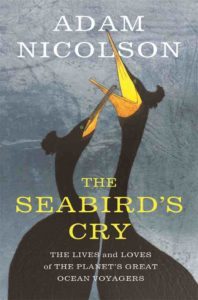The Seabird’s Cry ( Book Review)
When the author of The Seabird’s Cry was eight years old his father took him to visit a cluster of isolated, wild islands called the Shiants in North West Scotland. It was there that Adam Nicolson’s fascination with seabirds began.
“I think of them [the seabirds] strung and beaded around the cliffs….as the living skin of our ocean shores. They are the florid, rowdy summer clothing of what would otherwise be barren rock. I love the seabirds, partly because…. they [are] happy to display their beauty in the most demanding moment life can offer,” writes Nicolson.
350 species of Seabirds
Of the 11,000-odd species of birds, 350 have taken to the sea. Each chapter in The Seabird’s Cry is devoted to one group of ten different types of seabird, revealing intimate details of their lives. “The whole seabird is the vehicle of intelligence, its memory, its eye, it’s coloring, its aggression, its fear, its beauty.”
I am embarrassed to admit that before reading The Seabird’s Cry I lumped seabirds, along with land birds, into one large category: Birds. After reading this book, I know better. All birds are individuals within their species of similar characteristics. But because of the difference in their environments seabirds are dissimilar to land birds.
Seabirds vs. land birds
Nicolson does a great job of individuating the seabirds – the puffins are unique from the shearwaters, the gulls unique from the albatrosses. “For all their differences, a certain way of life unites them, different from most [land] birds: not living a year or two but, in the very oldest albatrosses, up to eighty or ninety years; not raising chicks the season after they are born, but slow to mature, waiting many years before laying an egg; not hoping against hope with eight or nine eggs in each clutch, but often raising a single chick, long incubated in the egg, long fed in the nest; rarely moving on from one partner to the next but often faithful for many years, each parent relying on the other to raise the next generation.
“These [seabirds] life-histories are shared, significantly, only by the vultures, which must also look for rare concentrations of prey in the wide and hostile sterilities of the world, not at sea but in the desert.
These are the edge-choosers, creatures whose lives have stepped beyond the ordinary into environments of such difficulty that they can respond only with a slow, cumulative mastery, which amounts in the end to genius.

Understanding seabirds help us to know all animals a little more intimately. Nicolson reminds us, “Unless we accept the multiplicity… with which every creature perceives the world in ways that are unique to it, we will inevitably end up ranking everything on a single scale, and that scale will be measured by our own human standards.
“Intelligence in animals … does not consist merely of tool-making, adapting bread as fish bait or curling leaves to extract ants from a hole.
“If you are stuck in that anthropocentric vision of nature,” writes Nicolson, “you will inevitably think that the more like humans any animal seems to be and the more linguistic and even technological skills they seem to have, the cleverer they are.
“We have no monopoly on intelligence. We would not know how to exist in a form that is not our own.”
These birds are the harbingers of the state of the oceans. Unfortunately, like most other non-human animals their numbers are in decline, by some measures showing a drop in seabird populations of 2/3rds over the past 60 years. In the chapter about shearwaters, I found his explanation about why some birds eat plastic sad but illuminating.
The stories and facts in The Seabird’s Cry were taken from scientists who have spent days and months living on cliffs studying these birds, and from available new technology small enough to attach to birds to understand their flight patterns, their relations to other birds, and their breeding habits.
Some of the experiments, especially those performed decades ago, made me cringe. But it is this new knowledge described in The Seabird’s Cry that will put me in a state of awe the next time I greet a flock of seabirds while walking along the ocean’s edge.
For other nature focused books I love, check out my favorites book shelf.
The post The Seabird’s Cry ( Book Review) appeared first on .



